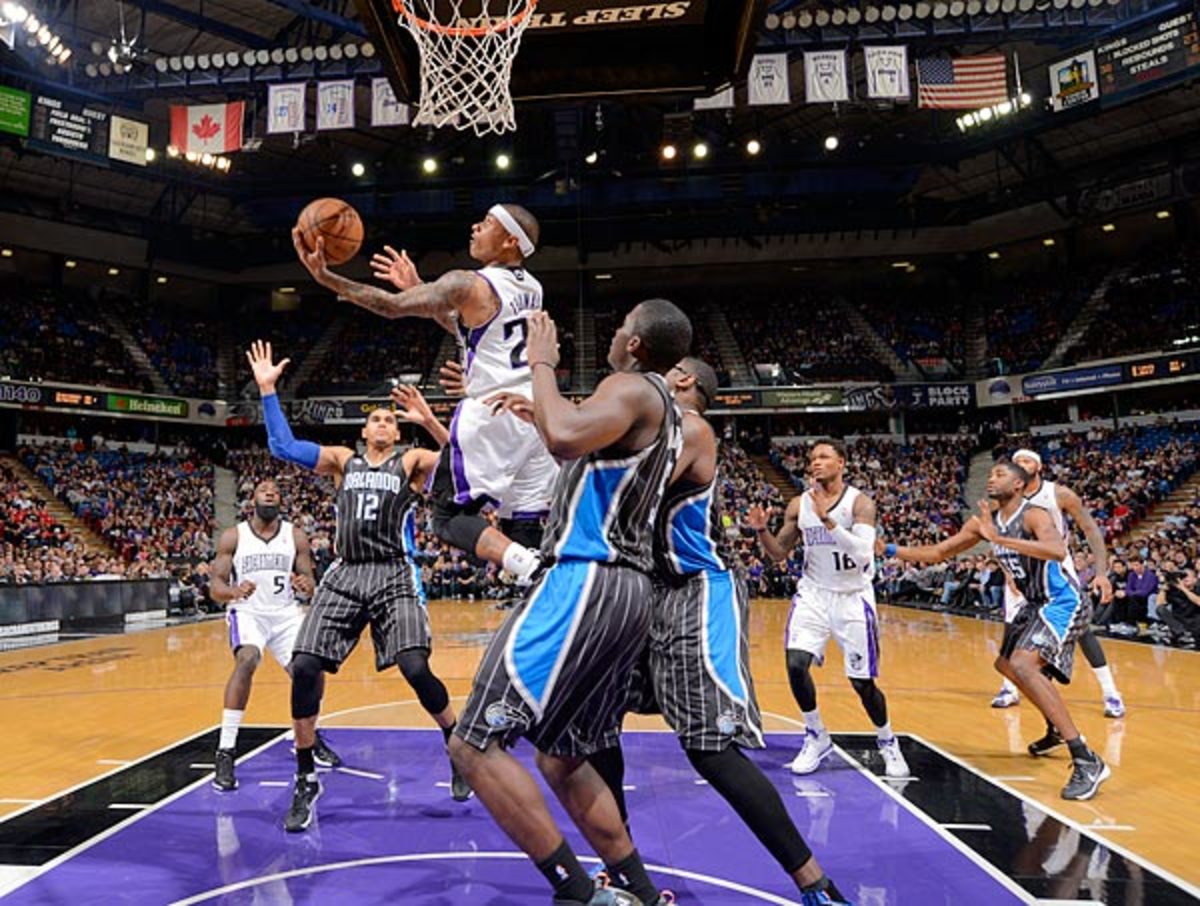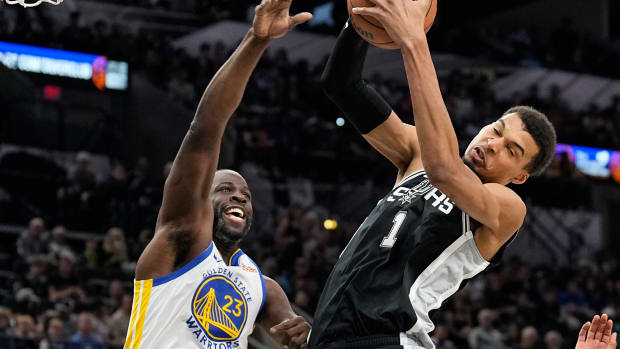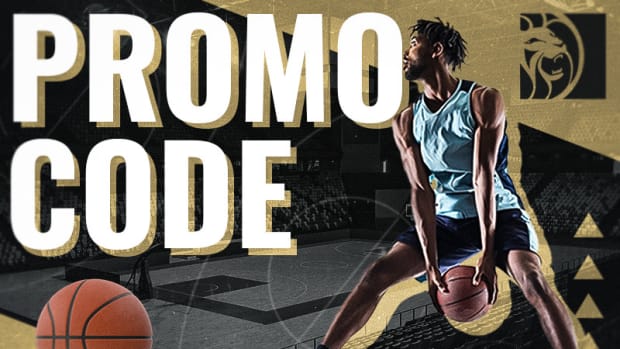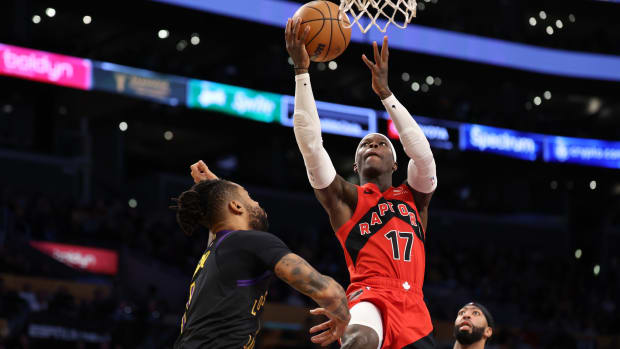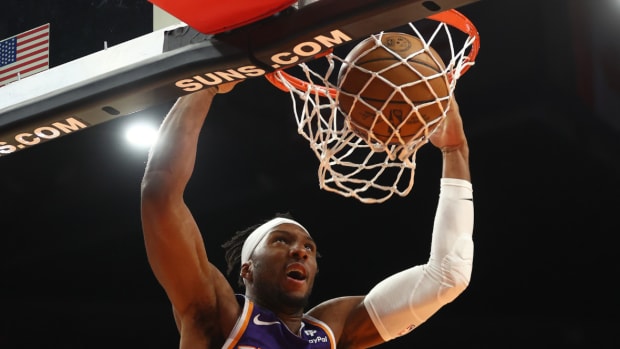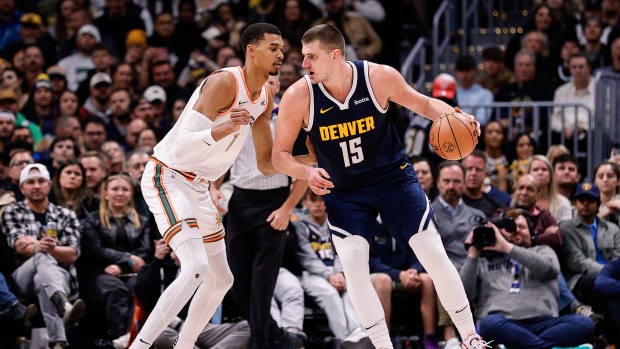The All-Payday Team: Five under-25 players who could cash in next summer
Isaiah Thomas is set for a huge pay raise when he becomes a free agent in July. (Rocky Widner/NBAE via Getty Images)
"The Point Forward All-Stars" will have a new theme each week centered on a single shared trait that brings together the team members. This week, SI.com looks ahead to the summer of 2014, when contract riches are waiting for some under-25 players.
Previously: The All-Grateful Team | The East's All-Letdown Team | The All-Atrocious Team | The All-Ignored Team | The All-Stocking Stuffer Team | The All-Recalibration Team
The All-Payday Team
Kobe Bryant already broke the Lakers' bank and a host of perennial All-Stars -- including LeBron James, Dwyane Wade, Chris Bosh, Carmelo Anthony and Dirk Nowitzki -- will have the opportunity to land big-dollar deals next summer.
But what about the next generation of earners? The following is a look at five under-25 players -- four pending free agents and one big man set to be eligible for an extension -- who will be in position to cash in come July. The group features lottery picks and second-round selections alike, and it includes players from both the 2010 and 2011 draft classes.
Notably absent from the quintet is Suns guard Eric Bledsoe, who is sure to see his salary spike next season. Bledsoe was passed over here because he was already included on The Point Forward's All-Stocking Stuffer Team and because he is sidelined with a knee injury.
Without further ado, SI.com's All-Payday Team.
PG: Isaiah Thomas, Kings
Few second-round picks deliver on their deals quite like Thomas, the 2011 draft's Mr. Irrelevant (the last player taken, at No. 60). Exactly what type of value are we talking about? By the end of this season, Thomas will have earned $2.1 million over his three-year, minimum-salary contract. That's equal to roughly 40 percent of what the Cavaliers paid Kyrie Irving, the first pick in 2011, during his rookie season alone; roughly 13 percent of what Cleveland has paid Irving over the last three years; and roughly 5 percent of what Bulls guard Derrick Rose has earned for playing a total of 49 games over the last three years.
Sacramento's return on that minuscule investment has been substantial: Thomas, who turns 25 next month, is one of just seven players averaging 19 points and six assists this season (the others are James, Chris Paul, Stephen Curry, John Wall, Irving and Russell Westbrook), and through Monday he ranked second among point guards in Player Efficiency Rating to Paul. Since moving into the starting lineup after the Kings' trade for Rudy Gay, Thomas is averaging 20.1 points and 7.3 assists. Those numbers are special by any standard, much less for a player earning $884,293.
Check out this table that compares the league's top 10 point guards by PER with their salaries entering Tuesday's games. Even compared to cost-efficient players still on their rookie deals (Irving, Bledsoe) and veterans who offer good value (Kyle Lowry, Mike Conley), Thomas is in a league of his own when it comes to production per dollar.
Look, it's easy for critics to point to Sacramento's poor record (13-23, second worst in the Western Conference), terrible defense (No. 28 in efficiency) and coach Mike Malone's repeated postgame meltdowns at his team's commitment this season and conclude that Thomas's numbers are subject to "bad team inflation." That's all well and good. Let's go ahead and concede that Thomas's defense needs considerable work -- work that might never get done given his 5-foot-9 frame -- and that his numbers wouldn't look quite as spectacular if he played for a more talented team that wouldn't sustain his monster usage rate. Still, there's no denying that Thomas has been the league's most underrated, overachieving offensive weapon this season.
The former Washington standout is quick off the dribble, creative in the air and pure with his shooting stroke. That combination makes Thomas capable of scoring in all of the most coveted ways: He's shooting 41.1 percent from three-point range, getting to the free-throw line more than five times per game (more often than Irving, Curry, Lowry, Tony Parker and a host of other point guards) and converting 52 percent at the rim (not incredible at face value, but certainly noteworthy considering his size).
After trading starting point guard Greivis Vasquez in the Gay deal, Sacramento's primary options at the position besides Thomas are Jimmer Fredette, a free agent in July, and 2013 second-round pick Ray McCallum, who has been shuttling to the D-League. That lack of depth should leave the Kings highly motivated to retain Thomas next summer, when Sacramento will be able to match offers for the restricted free agent.
What type of payday might be in order? Point guards such as Curry, Ty Lawson and Wall have signed rookie extensions for an average of more than $10 million annually, and while Thomas might not quite be in their category, his offensive ability should command well over mid-level money if guards like Monta Ellis, Brandon Jennings and Jeff Teague each pulled down at least $7 million per year in free agency last summer. A starting salary in the $8 million to $9 million range would represent a massive raise for Thomas and it might actually still be a good value. Consider: Thomas was the No. 20 scorer in the league through Monday, and the 19 guys above him average $12.5 million per year, a figure that actually undersells the money made by scorers, because five of those players are still on their rookie deals.
Guard Lance Stephenson is part of the Pacers' dominant starting lineup. (Jim McIsaac/Getty Images)
SG: Lance Stephenson, Pacers
Much like Thomas, Stephenson was a second-round gold strike. Taken No. 40 in 2010, "Born Ready" has put the off-court drama that nearly derailed his career behind him, emerging as a starter for the 2013 Eastern Conference finalists and growing into an All-Star candidate this year (albeit in a weak, injury-ravaged East backcourt crop). He's on the books for a cool $1 million; that bargain-basement salary made headlines in February 2013, when max-money teammate Roy Hibbert offered to pay a $35,000 fine on behalf of Stephenson after an on-court incident with the Warriors.
EXTRA MUSTARD: Stephenson wants your All-Star vote
The versatile Stephenson can score, move without the ball, run an offense, hit the glass hard and defend both guard positions. Ferocity is his defining characteristic, and it serves him well in all facets of the game: He finishes an excellent 63 percent of his shots at the rim, he ranks in the league's top 10 in defensive rating and, at 6-foot-5 with a 10.9 rebound percentage, he just might be the best inch-for-inch rebounder in the league. (Pacers blog 8 Points, 9 Seconds compares the league's best rebounding wings by the numbers right here, and Stephenson places tops among shooting guards.)
In a bit of a surprise, Stephenson, 23, has developed into the No. 2 scorer (13.3 points on 49.5 percent shooting) for an excellent Pacers starting unit in which all five players score in double figures. The fit in Indiana is excellent, as the Pacers' scoring balance and top-ranked defense limit the impact of his so-so outside shooting, but he's done enough this season to convince outside suitors that he's capable of succeeding in a larger role. Stephens still has untapped scoring potential, given that he's attempting fewer than 11 shots per game. If the leash is loosened, he's asked to create more for himself and some of the solid options (including Paul George and David West) surrounding him are stripped away, Stephenson's potential to score at least 18 points a game starts to seem conceivable.
DOLLINGER: Pacers lead Power Rankings
That will likely leave Stephenson with one of pro sports' age-old philosophical choices when he becomes an unrestricted free agent next summer: Take the money and run, or find a way to make things work with the Pacers. The latter approach could require agreeing to some measure of a hometown discount, as Stephenson should be the second-best shooting guard in free agency (behind Wade, who isn't exactly available).
SI.com's Chris Mannix reported last month that Stephenson could command between $7 million and $9 million per year, and Grantland.com's Zach Lowe in November estimated a salary in the $7 million to $10 million range. With the benefit of another long postseason showcase, it's easy to envision Stephenson achieving the high end of those ranges. For comparison's sake, Ellis, Kevin Martin and O.J. Mayo each received at least $7 million per year last summer, and Stephenson is arguably superior to all three while also entering a market without much quality competition at his position.
Indiana possesses the league's best record and its starting unit owns a monster plus-13.5 net rating. With the other four pieces (George, Hibbert, West and George Hill) locked in for next season, this is the type of group that should be kept together almost regardless of what it takes, even if that means breaching the luxury-tax line for the first time since 2006 (per ShamSports.com) or parting with key reserves.
The championship window is immediate and open -- potentially wideopen if the Heat's Big three disassembles next summer. The Pacers should therefore try to retain Stephenson under any circumstances, save an all-in, funny-money offer from a rival team. Cultivating a five-man unit as good as Indiana's starters is the hard part; paying -- or overpaying -- to maintain it should be an easier decision. Whether the small-market Pacers -- who will get Danny Granger off their books after the season but must start payments on George's max deal -- view things this way remains to be seen.
Gordon Hayward is averaging 17.1 points, 5.4 rebounds and 4.9 assists. (Nathaniel S. Butler/NBAE via Getty Images)
SF: Gordon Hayward, Jazz
Before the season, Hayward looked like a shoo-in for this payday quintet thanks to a laundry list of favorable conditions. An up-and-down season really hasn't changed anything.
What exactly is working in his favor? Well, he's the leading scorer and face of a rebuilding Utah team that would have a giant hole to fill on the wing without him. He's one of the top performers from his 2010 draft class, a group that has already seen the likes of Wall, George, Kings center DeMarcus Cousins, Jazz forward Derrick Favors and Bucks center Larry Sanders rewarded with eight-figure-per-year contracts. His organization will be well under the salary cap next summer without any dead-weight deals on its books, putting itself in prime position to match any offer for Hayward in restricted free agency.
Team and player talked about an extension before the deadline in October, but ESPN.com reported that the Jazz were unwilling to offer Hayward a four-year, $50 million contract, which would have represented about 80 percent of a max rookie-extension deal. Utah's refusal to go there is understandable because such a deal would have made Hayward richer than the likes of Trail Blazers forward Nicolas Batum ($46 million over four years) and Nuggets forward Danilo Gallinari ($42 million over four years) on their first contracts after rookie deals.
The 23-year-old Hayward has delivered, but not quite delighted, this season. Much like the Jazz as a whole, his play suffered when the team's projected starting point guard, rookie Trey Burke, missed the start of the season with a finger injury. His numbers -- career highs of 17.1 points and 14.5 shots side-by-side with career lows of 41.5 percent shooting and 31.7 three-point shooting -- have all the hallmarks of a player dealing with more offensive responsibility and more defensive attention than ever before. With Burke back, Hayward's shooting numbers have started to recover, and it would be a genuine surprise if they remain this unsightly at season's end.
The Jazz's rough November and December served as a nice evaluation period for Hayward. A max-level star would have been more successful in handling such adversity, but Hayward nevertheless led the Jazz in scoring and was the team's leading playmaker (4.9 assists per game) before Burke returned. He's also logged nearly 200 more minutes than any of his teammates, ranking as Utah's third-leading rebounder and top steals producer. That reliability and all-around production have major value, especially on a roster as young and thin as the Jazz's.
Hayward seems to be showing that he's fully capable of being a foundation piece, but not a go-it-alone superstar. Gallinari and Batum both fit the same bill and have eight-figure contracts to show for it; barring a major injury, there's absolutely no reason to believe Hayward will fall short of that standard. While the Jazz will be hoping that no one makes a monster offer to Hayward, they will also enter the summer knowing he's theirs to keep even if that worst-case scenario does unfold.
Greg Monroe hasn't had a monster year, but he'll still be an attractive free agent. ( Ron Hoskins/NBAE via Getty Images)
PF: Greg Monroe, Pistons
Like Hayward, his 2010 draft classmate, Monroe was a shoo-in for this list, not only because he carries a big man premium but also because he has been a full-time starter since midway through his rookie season. Those minutes -- more than 8,000 of them already -- have allowed Monroe to average roughly 15 points and nine rebounds for the last three years, a long track record that should appeal to any team with a frontcourt hole to fill. This equation is pretty simple: consistent production + 6-foot-11 height + no major injury red flags = payday.
That's true even though Monroe's fourth season, like Hayward's, hasn't been a smash hit. A big part of Monroe's expected price can be attributed to a lack of supply: He was the only big from the 2010 draft class with a proven track record who wasn't extended early, as Cousins (four years, roughly $60 million), Favors (four years, $48 million) and Milwaukee's Larry Sanders (four years, $44 million) all cashed in last fall. Given how similar Monroe and Favors are statistically, Favors' contract represents the floor for Monroe, and it's possible that the restricted free agency process winds up inflating Monroe's ceiling closer to the Cousins-like max level.
Monroe, 23, hasn't quite justified that type of major investment, though. His bread-and-butter is his combination of size and offensive versatility. He rebounds with purpose (especially on the offensive end), scores reasonably well from the post, faces up and puts the ball on the floor, and passes well for a big man. Unfortunately, Monroe still lacks the mid-range jumper that would make him a top-flight weapon; he's barely strayed outside the paint this season and, when he has, the result has been plenty of red on his shot chart.
He's also far from a stopper on the defensive end, and Detroit is once again lacking in that capacity this season, despite the addition of Josh Smith. Even though Monroe hasn't missed a game this season, he has blocked only 19 shots, a tally surpassed by the likes of 6-5 Victor Oladipo, 6-6 Danny Green, 6-7 Wesley Johnson and more than a dozen other players listed at 6-8 or shorter.
Those shortcomings aren't likely to stop someone from making Monroe a big offer. Detroit remains in the driver's seat because big-dollar deals for Charlie Villanueva and Rodney Stuckey expire at the end of this season and because center Andre Drummond is on a cheap rookie deal. Being able to keep the jumbo front line of Smith, Monroe and Drummond intact doesn't necessarily mean it's a good idea, though, which explains months of rumors surrounding Monroe that are certain to pick up again as the trade deadline approaches.
Bottom line: Unless Bosh decides to leave Miami (or is forced out for luxury-tax reasons), Monroe will likely enter the summer as the No. 1 "available" free-agent big man target. That will almost certainly lead some team to talk itself into extending an overly generous offer sheet, forcing Detroit to make a tough choice. A losing record, a below-average offense and defense and a subpar year from Monroe in the new frontcourt configuration are all indications that perhaps Detroit shouldn't stick too tightly to this core. There must be a better fit for Monroe than being squeezed between Drummond and Smith, right?
Nikola Vucevic has averaged more than 11 rebounds in 1½ seasons with Orlando. (Stephen M. Dowell/Orlando Sentinel/MCT via Getty Images)
C: Nikola Vucevic, Magic
Just as the contracts for Cousins, Favors and Sanders established benchmarks for Monroe, those early deals set a possible decision-making precedent for the Magic with Vucevic, one of the few extension-eligible low-post players from the 2011 class who can be expected to command a significant contract. (Vucevic, who is under contract for $2.8 million in 2014-15, is eligible to sign a rookie-scale extension beginning July 1 and ending Oct. 31. The deal would kick in for the 2015-16 season.)
The 23-year-old Vucevic represents an answer for an Orlando roster that is full of questions at virtually every other position. The Magic must sort out how best to use 2013 lottery pick Oladipo, decide whether to sell high on Arron Afflalo, figure out a replacement for point guard Jameer Nelson and hope that the best is still yet to come for Tobias Harris.
Vucevic, however, has already established himself as a steady backbone. His production has been comically consistent since he arrived from the Sixers in the four-way deal that sent Dwight Howard to the Lakers. It's a little bit eerie how bankable Vucevic has been: He averaged 13.1 points and 11.9 rebounds while shooting 52 percent in 2012-13, and he's averaging 13 points and 11 rebounds while shooting 51 percent in 2013-14. Similarly, his PER has changed by only a fraction from year to year and all of his other major numbers -- assists, blocks, steals and even fouls -- have barely moved.
The ex-No. 16 pick might not be the franchise's heir apparent to former No. 1 selections Shaquille O'Neal and Howard, but Vucevic is a reliable double-double guy who doesn't need the ball to be effective and has proved capable of ranking among the league's rebounding leaders. He has range on his jumper and he finishes at a slightly above-average rate at the rim. He certainly doesn't have Cousins' explosive offensive ability, but there's room to grow.
Of the three early-extending big men from the 2010 draft, Favors is probably the best comparison, as Vucevic lacks Cousins' star potential and Sanders' red flags. Favors' and Vucevic's third-year per-minute numbers are very similar, and the rebuilding Magic figure to be in roughly the same spot in the growth cycle next summer as the Jazz were last summer. At some point, you have to identify a core. After parting with Al Jefferson and Paul Millsap, Utah started that process with Favors, and Vucevic will be the first of the Magic's younger producers who can be locked up.






























